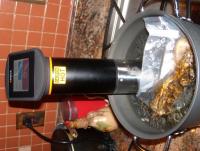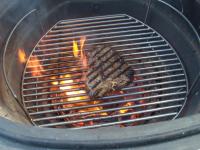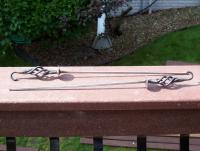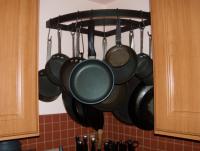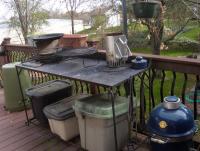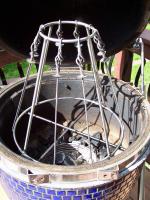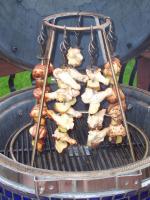-
Posts
12,622 -
Joined
-
Last visited
-
Days Won
537
Content Type
Profiles
Forums
Events
Everything posted by tony b
-
Saw this knife on Amazon and thought "What the Hell, Go For It". It arrived today and I was blown away by how nice this knife is - hefty, beautiful wood handle, and fairly sharp right out of the box. Will be using it to prep dinner tonight, so I'll let you know how it does in action. But still, for the price, one of the nicest knives I've run across. http://www.amazon.com/gp/product/B00MOOUHDU/ref=oh_aui_detailpage_o00_s00?ie=UTF8&psc=1
-
Good one, Doc!
-
No worries, mate (as they say down under!)
-
Good suggestions there, CC. Never thought about putting it back in the freezer. I usually prep my butts and briskets the night before and put them back in the fridge, taking them out at the last minute.
-
I agree that the new manifold is pure genius. Been trying to convince Dennis into making a version for the OTB-23, so the rest of us can take advantage. I'd be happy with the single dial with the holes in it to swap out for my regular draft door. (Hint, hint, Dennis).
-
Piece of advice to another fellow Midwesterner where it gets damned cold in winter - take out your thermometer and bring it inside. It gets cold enough here that it will "under range" and throw off the calibration. Which reminds me to go take mine out, too! This cold snap sneaked up on us!
-
We got 4+ inches of the white stuff last night, and it's like 8F with the windchill outside, so my a$$ is staying indoors. Making a pot of chili for dinner. Got ambitious and drug out the meat grinder and course ground half of the bottom round roast, cubed the rest. Simmering away after my 6 dumps of chile powders. Normally, I'd fire up the KK and grill some sirloin to toss into the chili pot, but like I said, too damned cold today! Nothing better than a bowl of red on a wintry day!
-
Hi, Larry! Where you been son? Been a while since you last posted. Hope all is well with you?
- 4 replies
-
- Pizza
- Pizza Dough
-
(and 1 more)
Tagged with:
-
Best vacuum packer? (FoodSaver alternatives?)
tony b replied to Syzygies's topic in Relevant Product Reviews
Here's a copy of my post about the sliding lid for my cambro box. No need to cut holes! http://komodokamado.com/forum/topic/4991-chicken-legs-thighs-and-breasts-cooking-in-sous-vide-bath-how-to-grill/#entry46596 -
New Grill Shaped 304 Stainless Drip Pans
tony b replied to DennisLinkletter's topic in KK Announcements
Hey Dennis, any updates on when the new web page and on-line store will roll out?? -
I have the original Anova model. Used it more than I thought that I would, actually. LIke Dennis said, it makes a great tool to go with the KK.
-
World Spice - Ingredients, Ingredients, Ingredients...
tony b replied to DennisLinkletter's topic in Relevant Product Reviews
Second that Doc! My "go to" is Penzey's. Also, one of the reasons that I love the Dizzy Pig products is their freshness. Check out a local company here near me (Iowa) - Frontier Spices. Lot's of organics. I rarely buy/use powdered garlic, but their's is off the chain good! When I buy in bulk, I break the product down into manageable portions and vacuum seal them. I try (emphasize "try") to remember to put dates on all my smaller jars so I know when to toss them and get new. Rule of thumb - ground spices are good for about 6 months if stored well (away from heat and light), whole spices are good for a year (or more, depending on what it is). Good "lesson learned" - tossed out almost half of a 4 oz jar of cardamom pods because I thought they were "old," only to find out that they keep pretty much indefinitely - costly that one! -
Never doubted your intelligence (we're both engineers after all), but I was beginning to doubt your taste - LOL! Will give you the benefit of the doubt from now on - promise!
-
My only challenge is patience - or lack thereof. I have a tendency to overshoot medium range cooks because when I open vents too far for my final temp (300F - 400F range) to "jump start" the cook, I let too much charcoal get going and even though I close the vents back down to final positions when the dome temps reaches 250F, it's too late and I end up higher than my target. As long as I catch it early, before the KK heat soaks, I can usually turn it around; it's when I get busy doing prep work in the kitchen and thinking all is well on the grill to finally discover - OOPS, I DID IT AGAIN! (sorry, bad Brittany pun.) So, I've tried to learn more discipline and just start the KK earlier and let it come up to temps "naturally," rather than jump start it. YMMV.
-
CC, dude, mushroom swiss burgers are da bomb, man! And, I gotta wean you off that damned Miller Lite! At least Fortune is a step in the right direction; but, beware, it's not a "light" beer at all - 6.9 percent alcohol by volume. 186 calories per 12-ounce serving. Try Sam Adams Light (119 Cal), if you're gonna stick to "light" beer.
-
You should be able to find it then, or at least the sumac and blend up your own. If not, Penzey's carries it. (btw - they are my "go to" spice store. Great stuff!) https://www.penzeys.com/online-catalog/zatar/c-24/p-486/pd-s
-
Thanks, CC. My gift to the KK community! Hope you can find someone locally to fab one for you. Here's a secret tip. Make a mock-up first to make sure that it fits. While mine was made for the old POSK, it still works on the KK - luckily. But, I have to remember to take out the dome thermometer, as it interferes with the rack, even on the lower grate. Bent the crap out of the thermometer the first time I used it on the KK when I closed the lid! Fortunately, it straightened out without breaking. Here's the other tip/trick - put a piece of potato on the end of the skewer, so the meats don't slide off as they cook (helps to put spuds in between too so all the meats don't slide down to the end (see pic above). Learned that one the hard way, too (LOL!) Susan, it came that way. I've never had any issues flipping it over to use as a sear grate. Thanks for the tips, Wilburpan. Will just use the "manual" method next time. Done that many times to put herbed butter under the skin of chickens. Best part of that video, listening to the crunchy skin as he's slicing it off the bird!! I can just taste it - Killer!
-
Speaking of old slaw recipes - here's one from the old Kamado (POSK) Forum that I've used a lot. It really goes well with pulled pork sandwiches (it's a Southern thing!) Posted by Barry on Thursday, September 08, 2005- 4:24pm: Here is a coleslaw recipe I like to use with the pork..I use Napa or Savoy cabbage. I like the texture and sweetness it gives to the slaw. Rinse off a head of Napa or Savoy cabbage, removing the outer leaves and discarding. Wrap it tightly and slice into about 1/4 inch thick. For the dressing I use 3/4 cup Best Foods mayonnaise 2T Balsamic Vinegar 1T Rice wine vinegar 1/2t colemans dry mustard 1T Sesame seed oil 1/2t white pepper 1T white sugar 2-3 cloves of garlic smashed and chopped Whisk it all together in a large bowl. Add chopped cabbage by the hand full while stirring to incorporate it all together. This is all approximate since I made this recipe up and never measure it. Just taste it. It is all good. I also add a spice mixture called Zattar. It is popular in the middle east, particularly Jordan. The main ingredients of Zattar are thyme, roasted sesame seeds and sumac. It is not readily available in stores. I would think a google search would find a supplier. Zattar adds a different flavor to the slaw that no one can figure out. It goes really well with the pulled pork though. It is also, I have found, indispensable when you want to K a really good leg of lamb. I add the Zattar when I make it - about a tablespoon. The sumac gives it a tart, lemony component. And, the other thing is to let it rest for a couple of hours to blend the flavors.
-
Old Kamado Forum
tony b replied to tony b's topic in The Ceramic World Online & Other Relevant Links
DRAT!!!! Of all the pieces of the old Forum that don't work, it would be the Pork section in the Recipes & How do I cook a ... thread!!! Well, at least the rest of it seems OK. -
It was custom made for me by the blacksmith shop down in the Amana Colonies. The skewers were an in-house basic item that I had them tweak by putting the hooks on the end. For the life of me, I can't recall what I paid them, but it wasn't a lot. They did several custom jobs for me back then - my pot rack for my kitchen remodel and my grilling table. Both were riffs on things that they routinely made for the gift shop. I just had them customize stuff for me. I just remember how cheap the pot rack was compared to what I found in catalogs for similar ones. I seem to remember that the hooks were the most expensive part of the deal!! The table got tiled during the house remodeling by the same folks that did the tile work in the kitchen. The blacksmiths just made the frame and the hooks, towel rack, etc.
-
Great looking duck, Wilburpan! Looking for tips on how to blow air under the skin. I tried several techniques and nothing I've tried seemed to work very well. Can't seem to generate enough pressure to separate the skin from the meat. Will be interested in how the rotisserie works out for you. I've done mine on vertical roasters (I don't have the roti for my KK). Sav, not to bring up too many bad memories, but the old POSK did have a meat hanger option. I never got one, but had something similar made locally for doing South American Churasco.
-
While many of us used to be on the old Kamado Forum, despite all the other issues with owning a POSK, there were a lot of good recipes and tips on that Forum (It's where I cut my teeth). I found a link to someone who had archived a lot of that old information if you ever want to peruse it. http://web.archive.org/web/20070623144413/http://www.kamado.com/discus/messages/2/2.html?1180985704
-
I can't actually believe it, but I read an article in the paper today on developing Ebola vaccines and they used the word "armamentarium." OK, that's twice in one week - freaky!
-
Appreciate the kinds words! My Mom passed back in '96. A lot of Thanksgivings ago! Still, like you said, to have just one more Thanksgiving with all of us around the table would be "priceless!"



